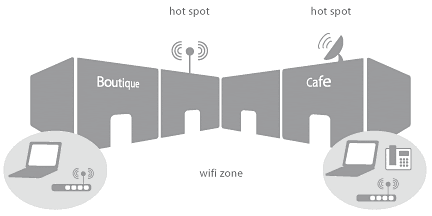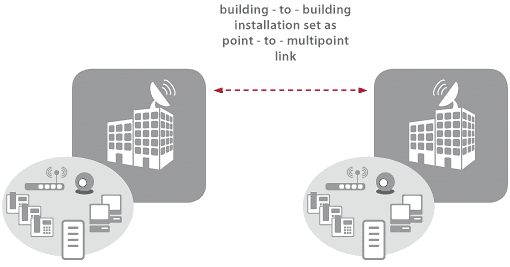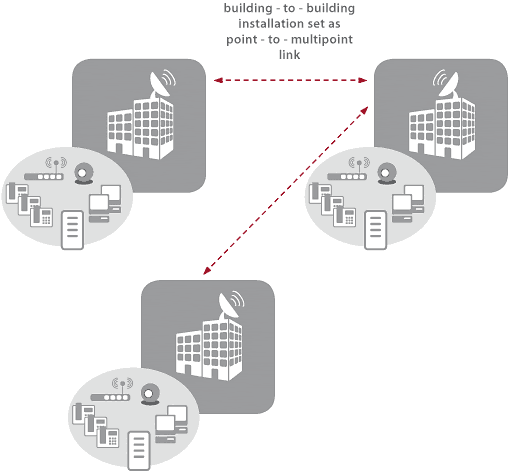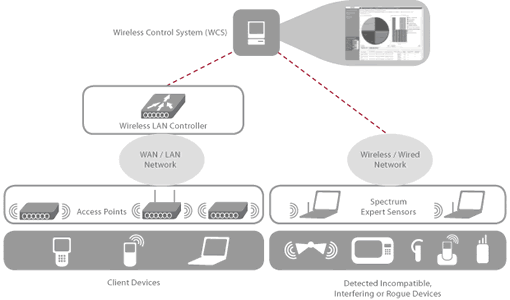
Wireless networks
Wireless networks are solutions which enable connections between computer networks for data transfer in open locations (outdoor installations) and closed spaces (indoor installations).
OUTDOOR INSTALLATIONS
Outdoor installations cover a wide area with wireless networks (e.g. Wi-Fi signal for tourist destinations). There are two types of such installations: Hotspot installations and Building-to-building installations
HotSpot installations
Hotspot installations are solution to cover attractive, mostly public locations, with a wireless network, such as city squares, but also hotels, marinas, airports, etc. These solutions are used to connect computer networks to transfer data (outdoors and indoors) via wireless Wi-Fi networks, in order to provide flexible services of Internet access. It is possible to cover a wide area and make so-called “Wi-Fi Zones” by grouping more Hotspot solutions.
Hotspot installations are solution to cover attractive, mostly public locations, with a wireless network, such as city squares, but also hotels, marinas, airports, etc. These solutions are used to connect computer networks to transfer data (outdoors and indoors) via wireless Wi-Fi networks, in order to provide flexible services of Internet access. It is possible to cover a wide area and make so-called “Wi-Fi Zones” by grouping more Hotspot solutions.

Building-to-building installations
By connecting local area networks (LAN) of two or more dislocated premises by wireless connections, costs of the leased communications lines or costs of building an own underground infrastructure, which is even difficult to carry out, are reduced. Such installations support distances from a few meters up to more than 30 kilometers, depending on the geographical conditions of the area. Special wireless „bridge“ devices are used, which are optimized for long distances and resistant to external atmospheric conditions. With regard to the number of locations and required performances, building-to-building installations can be set as point-to-point and point-to-multipoint links.
By connecting local area networks (LAN) of two or more dislocated premises by wireless connections, costs of the leased communications lines or costs of building an own underground infrastructure, which is even difficult to carry out, are reduced. Such installations support distances from a few meters up to more than 30 kilometers, depending on the geographical conditions of the area. Special wireless „bridge“ devices are used, which are optimized for long distances and resistant to external atmospheric conditions. With regard to the number of locations and required performances, building-to-building installations can be set as point-to-point and point-to-multipoint links.

INDOOR INSTALLATIONS
With regard to their function, there are two types of installations: for networking of offices, business and residential premises, and for networking of warehouse and wholesales premises.
Networking of offices, business and residential premises
Wi-Fi wireless network solutions are used more often as a substitute or extension of the traditional wire network infrastructure, since it provides better flexibility and mobility. The usage thereof contributes in savings in building and extension of local area networks compared to the cable version, and by improving wireless protocols such as roaming, enhanced security etc., the usage of new advanced technology like IP telephony is made possible.
Wi-Fi wireless network solutions are used more often as a substitute or extension of the traditional wire network infrastructure, since it provides better flexibility and mobility. The usage thereof contributes in savings in building and extension of local area networks compared to the cable version, and by improving wireless protocols such as roaming, enhanced security etc., the usage of new advanced technology like IP telephony is made possible.

Networking of warehouse and wholesales spaces(e.g. shopping malls, etc.)
The usage of Wi-Fi wireless technology in an organization simplifies the warehousing business operations and integration with ERP and WMS software solutions, together with technologies like BAR CODE and RFID.
The usage of Wi-Fi wireless technology in an organization simplifies the warehousing business operations and integration with ERP and WMS software solutions, together with technologies like BAR CODE and RFID.

NETWORK MANAGEMENT SYSTEMS
Wireless systems are more and more based on the “Wireless controller“ technology enabling centralized management of the complete local and remote wireless infrastructure. Such technology simplifies the management of a great number of devices at one place, and at the same time, offers new advanced roaming possibilities through the whole network on LAN, MAN and WAN level.


